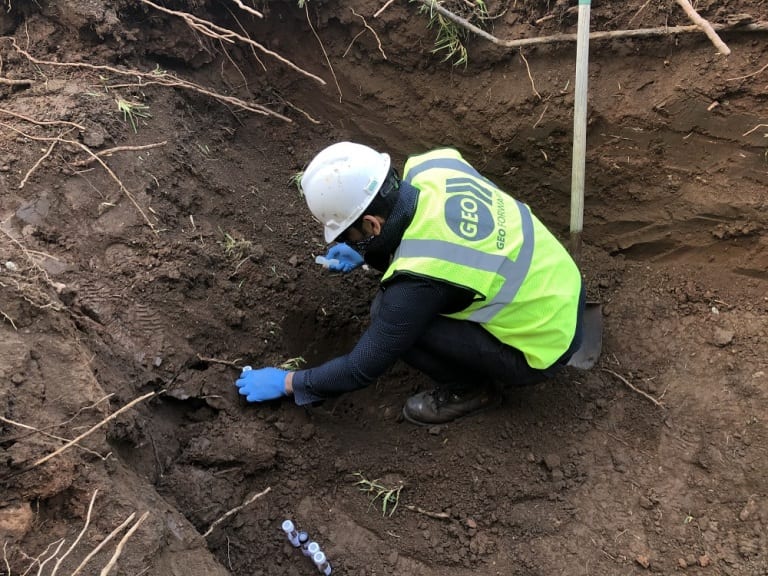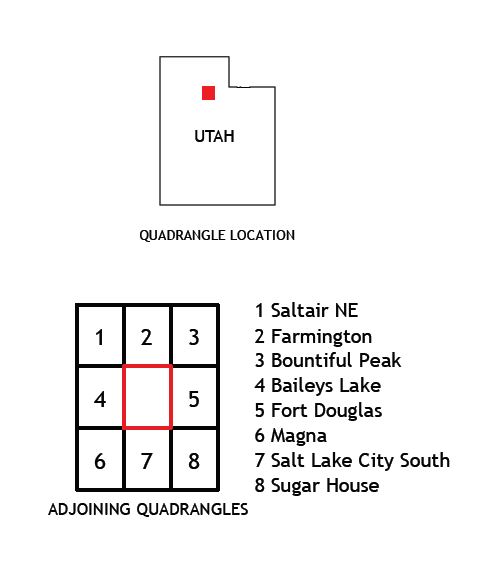Geology for Rock Climbers
Geology for rock climbers tends to be a science of newfound interest. A field of study, that apparently, wasn’t the most popular… Although to be honest, most people do remember Earth Science class in high school for its tranquilizing effect. But fast forward 10- to 20- years, and suddenly the booming sport has people everywhere enthusiastic about geology for rock climbers. One can reasonably presume this curiosity stems from a climber’s motive to enhance their performance. And of course, there is the obvious common denominator (rock formations).
With a wide variety of rock types out there, perhaps climbers aim to heighten their abilities in bouldering, top-roping, and sport-climbing with rock knowledge. On the other hand, perhaps a natural curiosity is born from the rush of problem-solving and triumphing over something greater than mankind itself. Something that is a natural part of this 4.6 billion-year-old planet. And something that might also be here long after humans as well.
“Geology for Rock Climbers” is an informative article by Adam Azad Kaligi, a professional geologist (lic. #9287) & rock climbing hobbyist – December 8, 2025.
Disclaimer:
This is an article about Geology for Rock Climbers. Rock climbing is a dangerous sport, which can result in serious bodily injury or death. This article solely intends to provide insight on the subject of geology for rock climbers. This article is not a guide on how to rock climb, nor does it intend to advise or motivate any person to rock climb. The author of this geology article recommends proper rock climbing lessons by a certified instructor, prior to any attempt to climb.
Additionally, readers of this article are not advised to rely on the information herein as a health and safety guidance. The author and administrator of this article do not, and cannot guarantee any safety measures in rock climbing. This article implies absolutely no liability, warranty, guarantee, or representation for health and safety. And no action or claim may be brought against the author or administrator of this scientific article, at any time.
Geologists and Rock Climbers
A seemingly timeless joke in the scientific community (and at most universities), is that “geologists are not real scientists…” They are often referred to as the “more-athletic” or “jock-like” members of the scientific community. Sadly, this is far from the truth (most of the time). Because physicists, mathematicians, and chemists practically lock themselves indoors when studying, they perceive their geological allies to be professional rock climbers or mountaineers of sorts. Or adventurers who just happen to kinesthetically research via rock climbing. And although these preconceived notions are typically incorrect, most geologists are flattered to be mistaken as rock climbers.
One thing is for sure. This animation- sitcom’s take on what geologists are like is certainly flattering:
In a Nut Shell
Nonetheless, the reality is that geology does require an enormous amount of reading, mathematics, physics, chemistry, engineering, and even biological background (paleontology). Years of studying, research, training, fieldwork, and examination are only part of a professional geology career. In fact, a wise professor of geology at the California State Polytechnic University in Pomona once summed it up nicely: “geology differs from most other disciplines of science and engineering, in that geologists study a little about a lot, whereas others study a lot about a little.” Of course, this does not discredit other fields of study at all. But rather explains the general nature of studying geology, for rock climbers.
The point here is, that there is a recognizable union of interests between geologists and rock climbers. And both groups can benefit greatly by sharing basic knowledge and experiences with each other. Thus, the purpose of this article is to share some basic information on geology for rock climbers.
Starting with the Geologic Time Scale
Geology for Rock Climbers 101: Rock climbers aspiring to understand geology, should begin with the geologic time scale. It’s not likely one will need to memorize (or even use) the time scale for rock climbing. However, this system is one of the foundational elements of earth science and can bring context to geology for rock climbers. Scientists use it to correlate earth events with geologic formations, and specific time frames of the planet’s history. These geologic time frames are called eons, and are broken down into eras, periods, epochs, and ages. In fact, a new geologic age has been added to the timescale for the current time frame, and it is called the Meghalayan Age. Furthermore, the geologic time scale has a chronological structure, beginning approximately 4.6 billion years ago.
As of now, scientists believe the earth is roughly 4.6 billion years old. The lower Precambrian represents the beginning of the earth. This time scale system is overseen by the Geologic Society of America. Alternatively, the International Commission on Stratigraphy publishes a similar geologic time scale.
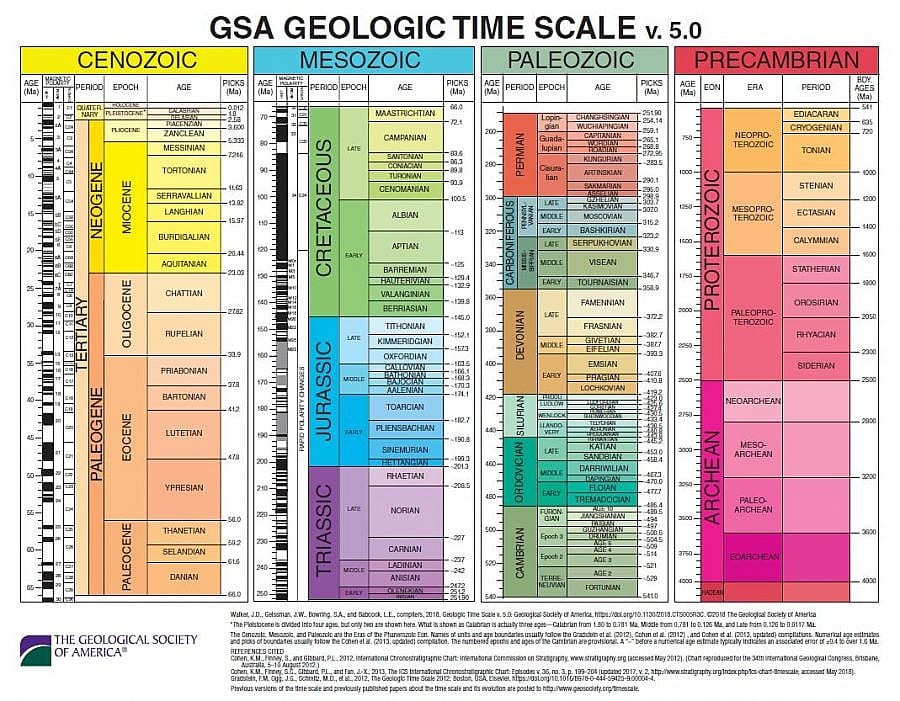 Geologic Time Scale as of 2020 by the Geologic Society of America
Geologic Time Scale as of 2020 by the Geologic Society of AmericaGeological Nomenclature
Nomenclature, in the subject of geology for rock climbers, can seem like a different language. Frankly, entry-level geology students view it the same. However, it’s important to understand that age strongly applies when classifying the very same rocks that climbers want to conquer. For example, a Miocene sandstone is a sedimentary rock with a depositional date ranging from 7 to 23 million years ago. The rock’s age and environmental effects (from weathering and erosion over time), plays an important role in rock climber interest.
Scientists quantify smaller time frames within each geologic age group by using the pretense terms “upper” and “lower.” For instance, a lower Miocene sandstone would have a depositional time frame from about 15 to 23 million years ago. Whereas an upper Miocene sandstone would have a depositional time frame from about 7 to 15 million years ago.
How & Why Rock Age Matters
Geologists determine the age of rocks using a few scientific techniques. Understanding these methods might not directly benefit a rock climber. However, a brief overview doesn’t hurt, and might even bring some clarity to the subject. Radiometric rate age dating includes carbon-dating methods and more. Biological rate dating includes analyzing amino acids within biomatter in soil. Evolutionary methods include the study of the fossils inside the rocks, and comparing their known time of existence. Last but not least, geologists implement various laws, such as the law of superposition and the law of cross-cutting relationships, to estimate rock ages and relationships.
Some interesting and trivial info on the geologic time scale:
- Geologists currently understand the earth began approximately 4.6 billion years ago, which is the Lower Precambrian supereon.
- Modern scientific theories indicate dinosaurs lived on earth 230 to 65 million years ago, during the middle Triassic period, the Jurassic period, and the Cretaceous period.
- Paleontologists support the current theory, that dinosaurs had gone extinct approximately 65 million years ago, during the upper Cretaceous period.
- In recent years, scientists have been developing theories about humans roaming the earth for the past 7 million years, during the upper Neogene period, and the Quaternary period.
Types of Rocks & Climbing Characteristics
There are three primary categories of rocks on earth:
Catagory of Rocks #1 – Sedimentary Rocks
Sedimentary rocks are one of the three geologic rock classifications discussed in the article. Many popular rock climbing sites are composed of sedimentary rocks. For instance, the sandstones and siltstones of the popular bouldering site, Stoney Point Park in Chatsworth, California, are sedimentary formations. And sedimentary rocks are a result of one or two processes: 1) the gradual consolidation of other loose particles, which form “Clastic Rocks,” and 2) precipitation from solutions forming “Chemical Rocks.” Depositional environments can be marine or land-based. And typical sedimentary rock climbing sites, are the types that form by the deposition of various earth materials.
Shale, sandstone, and limestone are the three most abundant types of sedimentary rock. Together, they form approximately 95% of the sedimentary rocks in the earth’s crust. Shale itself, comprises approximately 65% of all sediments on earth. Whereas sandstone and limestone are about 25% and 10%, respectively.
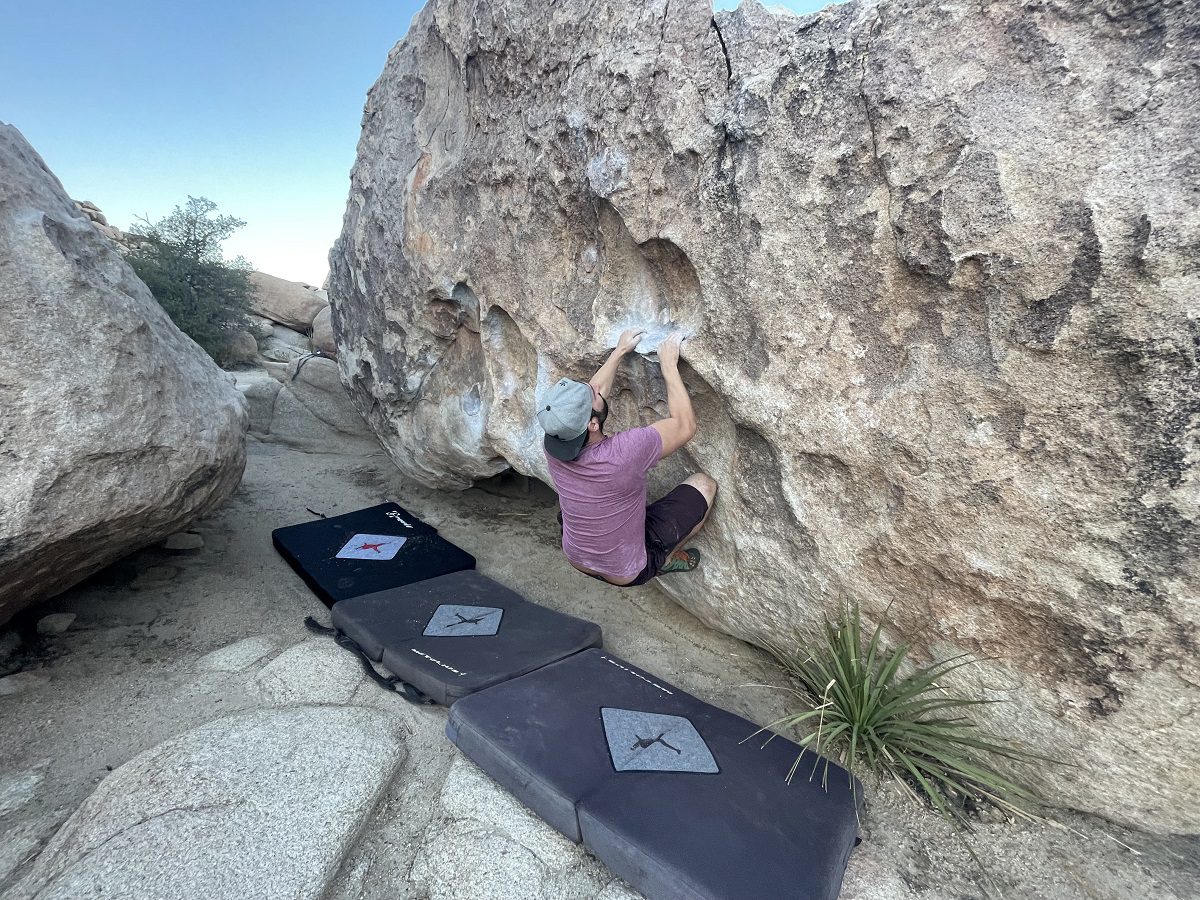
Clastic Sedimentary
Sedimentary deposits typically contain fragments of igneous rocks, metamorphic rocks, other sedimentary rocks, and various standalone minerals. Continental sedimentary deposits are normally a result of winds, landslides, mudflows, glaciers, and more. Marine sedimentary deposits are usually a result of oceanic water flow. Consequently, these formations usually (but not always) include bedding and layering patterns, as well as fossils. For instance, some rock climbing sites in California include the Modelo Formation, shallow marine siltstone, and sandstone. These are 15 million-year-old layered oceanic sediments, which have since been subject to uplift and overturn, and contain marine fossils.
Clastic rocks are classified according to particle size, sorting, distribution, and chemical content. And the size of these particles determines the rock’s name. For example, silt-sized grains form siltstone. Whereas clay-sized grains form a clay-stone, also known as shale. Moreover, sand-sized grains among mostly silt grains, form a sandy-silt. And the list goes on. Equally important, sorting and particle distribution provide evidence of the rock’s depositional environment. For example, most desert dune sands and beach sands have well sorting. Whereas sands from turbid current deposits generally have poor sorting.
Chemical Sedimentary
Chemical sedimentary rocks classify according to chemical composition, deposition, texture, and environment. Common examples are limestone, dolomite, coal, and more. Limestone is another marine sediment, which tends to be friable and weak compared to shale, siltstone, and sandstone. Consequently, it doesn’t make for a good rock climbing formation. Rock climbing handholds easily weather away, and anchor bolts aren’t likely to bear a proper load. On the other hand, limestone does have a calcium carbonate composition (similar to modern rock climbing chalk). In fact, natural chalk is a fine-grained type of calcium carbonate, whereas modern rock climbing chalk consists of magnesium carbonate.
Furthermore, limestone formations are known for their juxtaposition to shale and sandstone formations, due to a geological sequence called transgression and regression. As a result, perhaps one who studies geology for rock climbers can benefit from the use of a natural chalk source, as well as an enjoyable shale and sandstone site nearby.
Catagory of Rocks #2 – Igneous Rocks
Igneous rocks are another category and primarily originate from lava and magma. These rocks comprise about 75% of the earth’s crust on land and about 90% of the earth’s oceanic crust. They can be intrusive or extrusive, or as geologists put it: plutonic or volcanic. The classification of igneous rocks is based on mineral content and chemistry. For example, the plutonic igneous rock that makes up the popular rock climbing site El Capitan in Yosemite Valley, California is a granite, and is shown by the mineral content and grain size.
Generally, igneous rocks tend to be sturdy and make for great rock climbing and bouldering sites. Furthermore, of the three categories, it might be the best rock candidate for anchor bolting. However, the types of igneous outcrops can also play a huge role in a climber’s performance. For instance, plutonic igneous rocks can have fine grain textures (phaneritic), to coarse grain textures (aphanitic). And volcanic igneous rocks can have highly fine mineral texture (micro-crystalline), to fine with some distinct crystals (porphyritic). Some volcanic rocks even have a sharply pitted texture (vesicular) formed by bubbling when cooling.
Intrusive Igneous
Intrusive igneous rocks, or plutonic igneous rocks, form below the ground surface by large pools of magma. Giant bodies of magma inside other rocks or sediments identify as batholiths. And these batholiths chill over time to produce igneous rocks. Then-after, either the surrounding sediments erode away, or the rock gets uplifted and outcropped for rock climbers to conquer. There are various types of igneous rocks with a diversity of mineral compositions and crystal grain sizes. Consequently, the earth’s pressure and length of crystallization time play a significant role in the type of igneous rock produced. For instance, the faster the magma cools, the smaller the crystal grains tend to be. Whereas a slower crystallization time frame generally results in larger grains. Earth pressures additionally impact crystallization, as well as the mineral composition of the rock.
Extrusive Igneous
Extrusive igneous rocks, or volcanic igneous rocks, have been erupted on the surface of the earth, usually by mode of a violent ejection or explosion, or calmly by the flowing of lava. As a result, these igneous rocks are generally finely crystalline or glassy. Moreover, they are generally smooth and slippery, or sharp and jagged.
Although most igneous rocks will prove to be strong and reliable climbing outcrops, the various types and textures will affect the safety, comfort, and quality of one’s climbing experience. For example, a vesicular basalt would make for a jagged, sharp, and horribly painful handhold. Whereas a micro-crystalline basalt might be too smooth for sufficient gripping. But, a phaneritic or aphanitic granite may be a perfect combination of anchoring durability and handhold gripping texture.
Catagory of Rocks #3 – Metamorphic Rocks
Metamorphic rocks are the result of transforming versions of other sedimentary or igneous rocks (and sometimes, other metamorphic rocks). Metamorphism is the actual transformation process and occurs as a result of pressure, friction, heat, and time. Metamorphism, weathering, and erosion each play a significant role in geology for rock climbers. This affects the handhold texture, durability, and safety factor of the climbing experience. The changes to rocks can be chemical, physical, or both. Metamorphic rock types are studied in three general groups: strongly foliated; weakly foliated; and non-foliated. Foliation is the modification of rocks to be split into sheet sections.
Strong Foliation
A shale or siltstone (sedimentary rock), that undergoes low-grade regional metamorphism by pressure, will become a metamorphic rock over time, called slate. Slate typically has a strong foliation structure and is used for flooring, roofing, and billiard table materials. Similarly, slate makes for sturdy rock climbing material, as long as weathering, erosion, and fracturing haven’t affected the outcrop. On the other hand, slate does have a smooth and platey surface (foliation), which can be challenging for handholds. Moreover, rock climbing anchor bolts aren’t likely to be reliable in slate, due to the potential fracture planes in layering sections.
Weak Foliation
Other igneous rocks that undergo high-grade regional metamorphism, may become a gneiss. Without the aftermath of weathering and erosion, gneiss can make for a sturdy and well-textured rock climbing material. In terms of rock climber interests, gneiss likely shares many of the properties of plutonic igneous rock, such as granite. Otherwise, it can be brittle and unreliable.
Nonfoliation
A sandstone (sedimentary rock) that undergoes contact or regional metamorphism may become a non-foliated metamorphic rock called quartzite. Quartzite is one of many non-foliation types of metamorphic rocks and can offer a nice grippy texture and sturdy structure. Quartzite can make for a great rock climbing outcrop, as long as it is without the effects of weathering, erosion, and fracturing. Furthermore, drilling into quartzite for rock climbing anchor bolts may not be the easiest task, but also isn’t possible.
Most Favorable Rocks for Climbing
Overall, geological evaluations indicate the top choice climbing rock is an intrusive (plutonic) igneous rock, with phaneritic to aphanitic features. This includes granite, diorite, pegmatite, monzonite, and more. This rock type is equally favorable to bouldering, as it is to sport climbing and top roping. In fact, these igneous rocks have a higher degree of strength associated with anchor bolts. Furthermore, the rock surface textures make for nicely gripping handholds and are more resilient against weathering within a human lifetime (comparing to other sedimentary and metamorphic rocks).
Although less favorable than a plutonic rock, some extrusive (volcanic) igneous rocks can also be good for climbing. Despite the smoothness being a difficult handhold concern, basalt outcrops (with non-vesicular surfaces) are frequently climbed. Moreover, other porphyritic volcanic rocks, such as rhyolite and andesite provide many (but not all) of the same benefits to rock climbers as a plutonic igneous rock.
2nd & 3rd Most Favorable Rocks for Climbing
The next favorable rock (particularly for bouldering) is a fine to coarse grain, strongly consolidated, clastic sedimentary rock, such as siltstone or sandstone. The sandy content of these rocks continuously provides a good gripping texture for handholds and footholds, even through weathering and erosion. However, these sedimentary rocks are more susceptible to structural weakening by erosion and weathering over time. As a result, there is a lesser degree of certainty and reliability with anchor bolts. Thus, it is most ideal for bouldering with the use of a crash pad. And less ideal for sport-climbing and roping.
Lastly, some favorite rock climbing sites include un-eroded and non-weathered shales (sedimentary rocks) and gneiss (metamorphic rocks). Without the compromising effects of weathering, erosion, and metamorphism, these rocks can bare the proper characteristics for desired for bouldering, and potentially sport-climbing. Although, there is a lesser degree of reliability with rock climbing anchor bolts on sedimentary and metamorphic rocks, comparing to igneous rocks.
Types of Outdoor Rock Climbing
When it comes to embarking on rock climbing outdoors, there are more varieties than what meets the eye. There are at least seven different types we know of. But the more commonly known are sport climbing, traditional climbing, and free climbing.
Among these three, they vary based on a few factors. While sport climbing involves the use of climbing rope and quickdraws to set up an already bolted rock face (meaning, previously climbed before and bolts have been drilled into the wall), traditional climbing is ascending a route that is not previously bolted. Instead, it involves the use of cams and a different set of professional equipment to wedge into the rock cracks and gaps before looping the rope in. This protects the rock surfaces better in the long run and it is also more common in countries like the United States where the climbing spots are mostly traditional (trad) climbing.
Free climbing, recently made even more mainstream famous by the movie “Free Solo,” is basically rock climbing without a rope. This can be highly dangerous. Hence, it is not recommended for anyone, even advance climbers.
Alternatively, during times when one must stay at home, a trusty hangboard is a viable option for practice. Nonetheless, climbing in the outdoors is extremely rewarding. Understanding geology for rock climbers, and being one with nature beats any indoor gym experience.
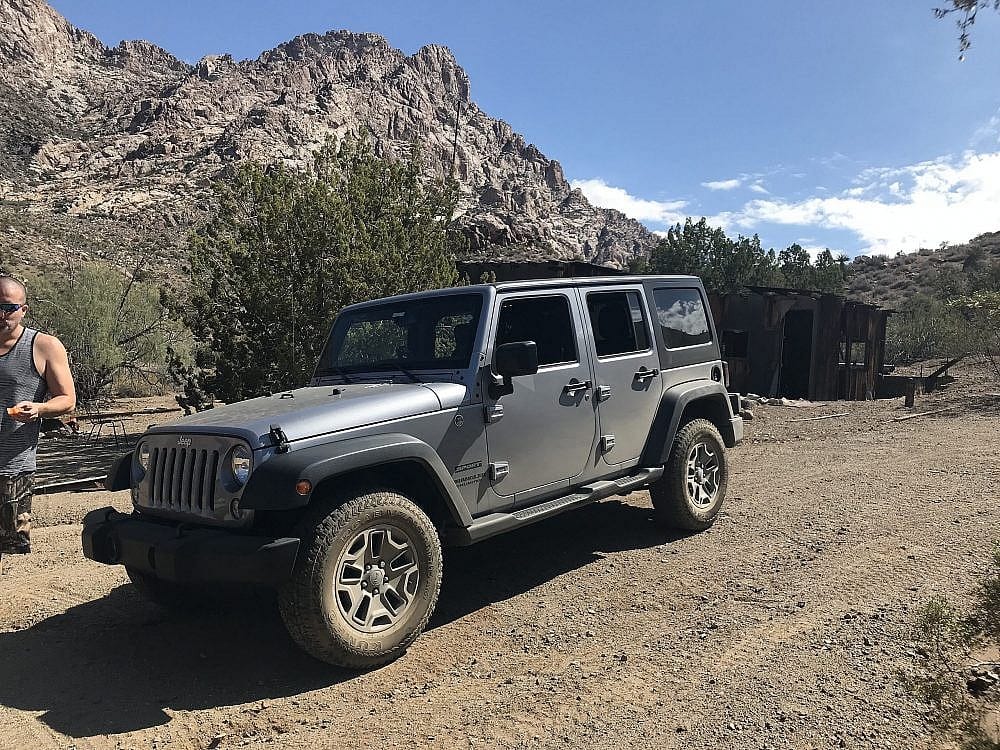 Rock Climbing Geology and Off-Road Trails – Jeep by Adam Azad Kaligi, Professional Geologist
Rock Climbing Geology and Off-Road Trails – Jeep by Adam Azad Kaligi, Professional GeologistThe Geology of Popular Rock Climbing Spots
The following is a list of popular climbing sites, along with a brief on the geology for rock climbers. Popular Rock Climbing Sites:
El Capitan, Yosemite National Park, California
El Capitan is a plutonic igneous rock. In particular, it is a large granite batholith from the Cretaceous Period and is a result of glacial carving.
Red River Gorge Geological Area, Daniel Boone National Forest, Kentucky
The primary geologic formation for rock climbers in the Red River Gorge area is the Corbin Sandstone. This is a clastic sedimentary rock from the Carboniferous Period and is a result of shallow river delta deposits. Since deposition, the formation has been uplifted and overturned.
Gibraltar Rock, Santa Barbara County, California
The rock climbing sites of Gibraltar rock are within a well consolid clastic sedimentary formation known as the Matilija Sandstone. This sandstone is extremely hard. As a result, rock climbers report that this formation is proper for top-roping, with reliable anchor bolts. Moreover, the rock texture includes good handhold grips, thus ideal for bouldering with a crash pad. The sandstone deposition occurred during the Upper Eocene Period, and is a result of other granite particles from nearby decomposing outcrops, consolidating in a shallow marine environment.
Rumney Rock Climbing Site, Rumney New Hampshire
The Rumney Rock Climbing Site is a popular spot for sport climbers. The geology of this area is complex. Thus, outcrops may be variable from site to site. Nonetheless, a general overview of the State Geological Map indicates the overall climbing site comprises metamorphic-sedimentary and metamorphic-igneous rocks. And the geologic structure is referred to as the “Central Maine Trough.” These varieties fall within the “greenschist” to “granulite” categories on the metamorphic facies plot. The climbing area also includes structural belting, because it is between two major faults.
The climbing area is broadly mapped as the “Dlu” unit, which is the upper member of the Central Maine Trough. This is a light gray substance with layering (similar to the Seboomook Formation in Maine). The metamorphic rocks in this area appear to be “AB,” which are amphibolites. And the plutonic rocks appear to be granitoids.
Consequently, the geological conditions at this site have the potential to be great climbing material for bouldering and sport-climbing purposes (particularly the solid igneous units). However, because of the regional metamorphosis, it’s possible that some outcrops here have a compromised degree of strength. Thus, one should be selective about anchoring. Moreover, proper testing of any anchors is a strong recommendation prior to reliance.
Authors:
Written By: Adam Kaligi


